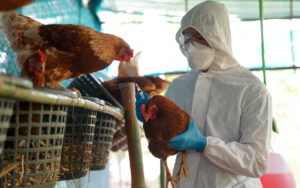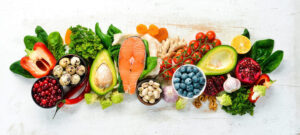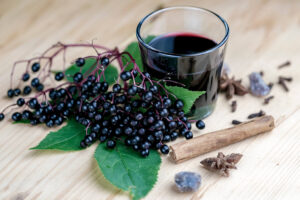Bird Flu Outbreak:
April 26, 2024
Dr. Joshua Levit
Last month, the USDA warned that millions of wild birds like ducks, geese, and swans had been infected with bird flu.
A week later, we learned that it had spread to flocks of backyard chickens. 
Next came announcements about infections in large commercial chicken farms.
Soon after, reports started coming in across the country about “bird flu” cases in mammals, not birds. Skunks in Washington. A mountain lion in Montana. Raccoons in Kentucky.
A few weeks later, it had spread to dairy cows in Kansas, New Mexico and Texas. It was making them sick and affecting their milk supply.
At the time, the USDA and CDC made statements that “there is no concern about the safety of the commercial milk supply” and that there was no risk to human health.
Then came an announcement that viral fragments had been found in pasteurized milk…followed promptly by another set of statements that there was nothing we needed to worry about.
Not long after that…an employee in the cattle industry in Texas tested positive.
Patient zero.
The current bird flu outbreak is caused by the H5N1 strain of the avian influenza virus and, as described, has been detected in various species, including wild birds, poultry, and mammals, including dairy cows across the United States.
Federal agencies note that while bird flu remains primarily an animal health issue, the general public’s risk is considered low. However, there have been isolated cases of human infection, predominantly among individuals with direct exposure to infected animals.
The outbreak has prompted increased surveillance and biosecurity measures to prevent the spread of the virus among poultry and other susceptible animals. Despite these measures, the H5N1 strain has shown a capacity to affect a wide range of mammals, which is atypical for bird flu, indicating a potential for a bigger, broader, multi-species impact.
From a human public health perspective, the CDC and other health agencies are monitoring the genetic evolution of the virus to assess any potential increase in risk to humans. Current data suggests that the currently circulating strain virus does not cause serious disease in humans, and there is no evidence of sustained human-to-human transmission.
In terms of food safety, both the USDA and the FDA have repeatedly announced that poultry and dairy products on the market are safe for consumption when properly prepared, cooked, and consumed. At present, it appears that poultry and dairy products on the market are safe… although we may soon see price increases that reflect the increased costs of this outbreak on the poultry and dairy industries.
How To Strengthen Immunity
 The current H5N1 bird flu outbreak still primarily affects birds, but there are theoretical risks to humans, particularly for those in close contact with infected animals. Although human cases have been rare and typically associated with direct exposure to infected birds, the potential for the virus to mutate and spread more easily among humans cannot be completely dismissed.
The current H5N1 bird flu outbreak still primarily affects birds, but there are theoretical risks to humans, particularly for those in close contact with infected animals. Although human cases have been rare and typically associated with direct exposure to infected birds, the potential for the virus to mutate and spread more easily among humans cannot be completely dismissed.
As our federal agencies continue to monitor this outbreak and the genetics of the virus…we should do everything we can to ensure that our immune systems are strong and capable.
IMMUNE SUPPORT
As a naturopathic physician, I believe that the outcome of any infection (including bird flu) can be improved with attention to the health of the immune system. This outbreak is an opportunity to shore up our defenses and improve the chances that we come out the other side in one piece. Here is a list of the most important ways that you can support your immune system:
The first thing to understand is that: An infection is a RELATIONSHIP.
It’s a relationship between an organism (like a virus) and a host (like a human).
The outcome of that relationship depends on factors related to both the organism AND the host. In much the same way that a cheetah catches and kills the weakest/slowest antelope in the herd…viruses generally do the same thing. The healthy, fast antelopes at the front are more likely to be spared….it’s the ones at the back of the pack (older, weaker, sicker etc) who are most vulnerable.
So…when an organism is spreading, it’s like the cheetah on the prowl…and you need to do everything you can to stay at the front of the pack.
Below, you’ll find my list of top natural “anti-viral” approaches to help keep your immune system strong…and make sure that you are at the front of the pack.
1) Foods To Eat: The best fuel for your immune system is a minimally-processed, “down to earth” diet. That means eating foods that come from farms and fields and fisheries…not factories.
-
- Eat vegetables, fruit, nuts and beans.
- Eat only animal products like meat, poultry, eggs, dairy that come from healthy animals that were pasture-raised, grass-fed, and raised in an organic, sustainable, regenerative way.
- Eat lots of spices: ginger, garlic, turmeric, oregano, thyme, rosemary all have antiviral and immune-supportive properties.
- Drink lots of green tea. It contains an immune-supportive compound called EGCG. Pro tip: dark chocolate contains EGCG too!
2) Foods To Avoid:
-
- Avoid added sugar, high fructose corn syrup, and foods or drinks that contain added sweeteners. Honey is the sweetener of choice.
- Avoid the unhealthy fats found in fried food, and foods processed with ultra-processed “vegetable oils”
- Minimize ultra-processed foods in general. Shelf-stable foods in cans, jars, etc should only have a short list of ingredients that you can read and recognize.
3) The Three S’s:
a) Sleep: 7 hours minimum. More if you’re sick. Don’t stay up late watching the “bad news”…turn it off an hour before bed.
b) Stress: We can’t eliminate stress, but the way we respond to it is a choice that is in our control. Uncertainty is fuel for anxiety, and these are uncertain times. But remember, panic almost never helps anything.
c) Smoking: There has never been a better time to stop smoking.
4) Physical activity: Keep your physical activity going…outside whenever possible.. Super heavy exercise can depress immunity, while moderate exercise improves immunity. Long walks, hikes, short runs, bike rides…try to move your body outside.
5) Water:
- Hydration: Stay hydrated. No need to overdo it. Consider using your last sip to gargle…believe it or not, there is actually some research that suggests gargling water might decrease the risk of respiratory infection.
- Humidification: Viruses do better in dry air. Consider using a humidifier if your indoor air is dry.
- Hygiene: Yes, hand washing. For at least 15 seconds. Focus on your fingertips.
6) Vitamins and Minerals:
-
- Vitamin A: Commonly used in doses of:
- 5,000-10,000 IU is a reasonable dose for prevention
- Up to 100,000 IU for three days during viral infection.
- DO NOT USE in pregnancy, nursing, or liver disease.
- Vitamin C:
- 1-3 grams per day for prevention
- up to 10,000 mg (or 10 grams) for treatment.
- Divide doses throughout the day to improve bowel tolerance
- Vitamin D: Target lab test level of 40-60
- 2000-4000 IU daily
- Zinc:
- Prevention: 15-30 mg daily,
- Up to 75 mg daily for treatment.
- Zinc acetate or gluconate in lozenges is probably best.
- Too much in one dose will cause nausea. Divide it up.
- Vitamin A: Commonly used in doses of:
7) Other supplements:
- Probiotics: There is an entire ecosystem of microorganisms that live within our bodies. When that ecosystem is healthy, we are more
 likely to be healthy as well. Take a high-quality probiotic daily.
likely to be healthy as well. Take a high-quality probiotic daily.
- N-Acetylcysteine (NAC):
- 1800mg day in divided dose for prevention.
- Associated with higher likelihood of asymptomatic viral infection
- Quercetin: A bioflavonoid compound found in onions. Research is promising for antiviral and immune-supporting properties.
- 1000mg daily.
- Monolaurin: Derived from lauric acid which is found in coconut: 300mg three times per day with food.
- Propolis: An antimicrobial product produced by honeybees. Commonly used in throat sprays.
8) Herbal medicines: Herbal formulas are often complex multi-herb formulas…so it’s difficult to get exact dosages…The following are ingredients to look for in an herbal immune support formula: 
- Elderberry (Sambucus nigra): One tablespoon of syrup two to four times per day. You’ll read warnings online about the possibility that elderberries might increase the risk of “cytokine storm” in viral infections. There is no reliable evidence that concerns me.
- Skullcap (Scutellaria baicalensis): Widely used by herbalists all over the world for viral infections. A typical product in a capsule might contain 350-500mg of a dried herbal extract. Take two of those three times daily.
- Andrographis (Andrographis paniculata): Look for a product that contains andrographolides…shoot for 50-60mg of andrographolides per day.
- Astragalus (Astragalus membranaceus): A famous and well-studied herbal immunomodulator. Look for a product that contains a standardized extract and take about 2 grams, that’s 2000 mg daily.
- Cordyceps (Cordyceps sinensis): Commonly known as the “caterpillar fungus, this is a medicinal mushroom widely known for use in lung disease. Typical doses are about one gram (1000mg) daily for prevention and up to three grams in the case of illness.
 9) Be Flexible: Have you ever seen a palm tree in a hurricane? They survive the storm because they are flexible. If an infection is spreading or even if you’re already sick…stay calm, take it day by day, and ride it out.
9) Be Flexible: Have you ever seen a palm tree in a hurricane? They survive the storm because they are flexible. If an infection is spreading or even if you’re already sick…stay calm, take it day by day, and ride it out.
Disclaimer:
The information presented here is for educational purposes only. It is not a treatment or prevention for any medical problem. It is not a substitute for medical advice from your personal physician and is not a substitute for the advice from your local, state, or federal authorities.











